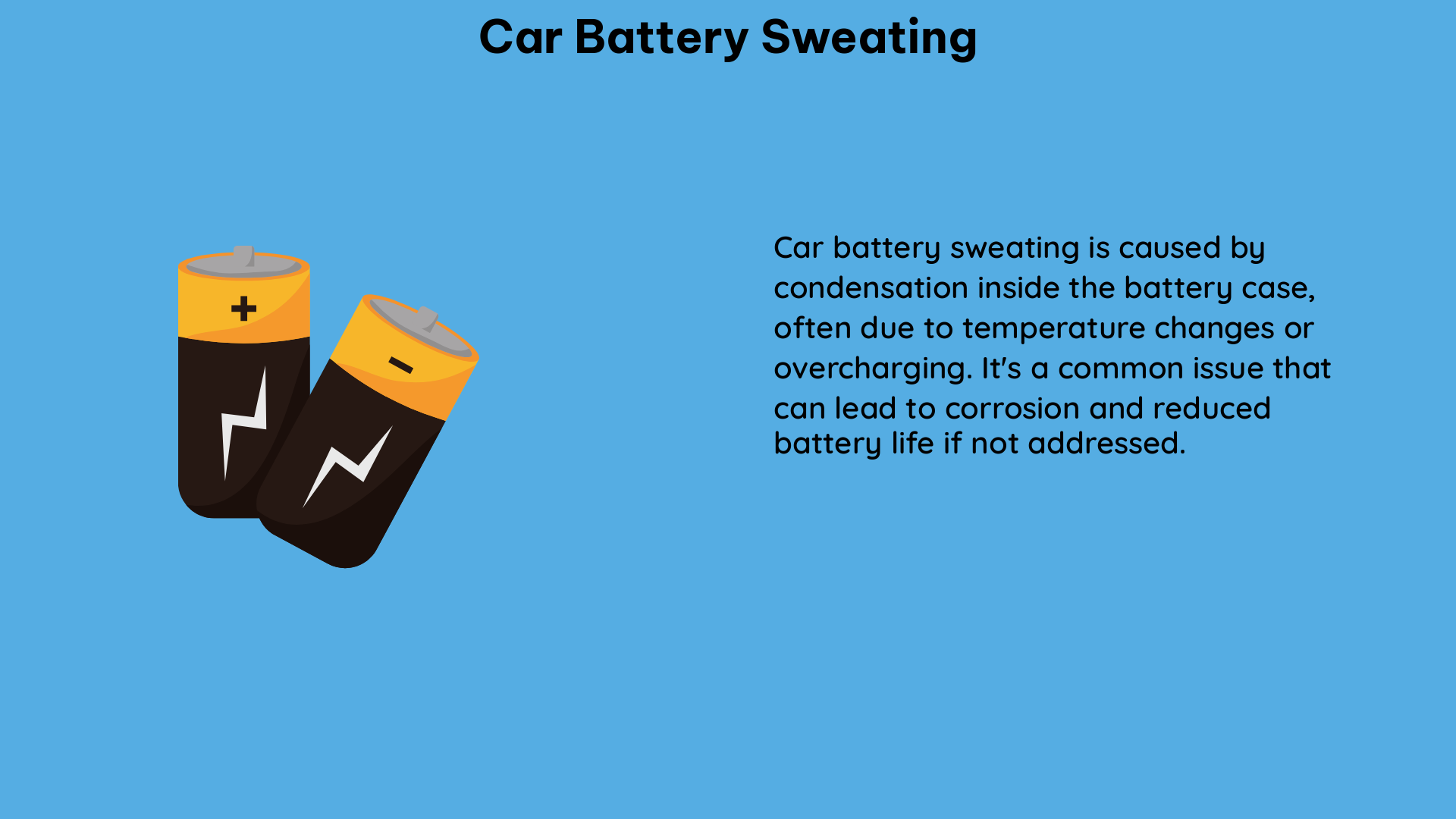Car battery sweating, also known as battery leakage, is a common issue that can lead to various problems such as corrosion, reduced battery life, and even damage to the vehicle’s electrical system. This comprehensive guide will delve into the technical details of car battery sweating, providing you with a thorough understanding of the underlying causes, diagnostic methods, and effective preventive measures.
Understanding the Causes of Car Battery Sweating
The primary cause of battery sweating is the buildup of condensation on the battery’s surface, which can occur due to several factors:
-
Temperature Fluctuations: Rapid changes in temperature, such as moving the vehicle from a warm environment to a cold one, can lead to the formation of condensation on the battery’s surface.
-
High Humidity: In areas with high humidity, the air can hold more moisture, increasing the likelihood of condensation forming on the battery.
-
Overcharging: When a battery is overcharged, it generates hydrogen gas, which can escape through the battery’s vents and mix with the surrounding air. This mixture can create a corrosive acid that can damage the battery terminals and other nearby components. The escaping hydrogen gas can also condense on the battery’s surface, leading to the appearance of sweating or leakage.
To quantify the extent of battery sweating, you can measure the amount of condensation or leakage on the battery’s surface. A battery that has been in use for several years may exhibit a significant amount of corrosion and leakage, indicating a reduced battery life and the need for replacement.
Factors Influencing Battery Sweating

The frequency and severity of battery sweating can be influenced by various factors, including:
-
Battery Age: Older batteries are more susceptible to sweating due to the gradual deterioration of internal components and seals.
-
Battery Type: Different battery technologies, such as lead-acid, lithium-ion, or nickel-metal hydride, may have varying susceptibility to sweating.
-
Maintenance History: Proper maintenance, such as regular cleaning and checking for corrosion, can help mitigate battery sweating.
-
Ambient Temperature and Humidity: Extreme temperatures and high humidity can exacerbate the formation of condensation on the battery’s surface.
Diagnosing Car Battery Sweating
To diagnose car battery sweating, you can follow these steps:
-
Visual Inspection: Examine the battery for any signs of corrosion, leakage, or visible condensation on the surface.
-
Voltage Measurement: Use a multimeter to measure the battery’s voltage. A significantly lower voltage than the recommended range may indicate a problem with the battery.
-
Specific Gravity Test: Use a hydrometer to measure the specific gravity of the battery’s electrolyte. This can help determine the battery’s state of charge and identify any issues with the internal components.
-
Load Test: Perform a load test to assess the battery’s ability to deliver the required current under load. This can help identify any underlying issues that may be contributing to the battery sweating.
Preventive Measures for Car Battery Sweating
To prevent or mitigate car battery sweating, you can take the following measures:
-
Battery Terminal Maintenance: Regularly clean the battery terminals to remove any corrosion buildup. Use a wire brush or baking soda and water solution to clean the terminals.
-
Proper Charging: Ensure that the battery is charged correctly and not overcharged. Use a battery maintainer or trickle charger to keep the battery at full charge during periods of non-use.
-
Battery Insulation: Install a battery warmer or insulation to protect the battery from extreme temperatures, which can contribute to the formation of condensation.
-
Ventilation Inspection: Check the battery’s ventilation system and ensure that it is not obstructed or damaged, as this can affect the battery’s ability to release hydrogen gas and prevent sweating.
-
Battery Replacement: If the battery is severely corroded or exhibiting signs of significant leakage, it may be necessary to replace the battery to prevent further damage to the vehicle’s electrical system.
By understanding the technical details of car battery sweating and implementing the appropriate preventive measures, you can ensure the longevity and reliability of your vehicle’s battery and electrical system.
References:
- Hu, X., Zheng, Y., Howey, D. A., Perez, H., Foley, A., & Pecht, M. (2020). Battery warm-up methodologies at subzero temperatures for automotive applications: Recent advances and perspectives. Journal of Power Sources, 456, 228357. doi:10.1016/j.jpowsour.2019.228357
- Battery leaking/sweating. Why? – The BangShift.com Forums. (2009, January 07). Retrieved May 26, 2024, from https://www.bangshift.com/forum/forum/bangshift/tech-section/7773-battery-leaking-sweating-why
- Battery “sweating” – MX-5 Miata Forum. (2006, December 24). Retrieved May 26, 2024, from https://forum.miata.net/vb/showthread.php?t=212844
- battery in trunk sweats a lot?? – Chevrolet Cruze Forums. (2017, April 24). Retrieved May 26, 2024, from https://www.cruzetalk.com/threads/battery-in-trunk-sweats-a-lot.198434/

The lambdageeks.com Core SME Team is a group of experienced subject matter experts from diverse scientific and technical fields including Physics, Chemistry, Technology,Electronics & Electrical Engineering, Automotive, Mechanical Engineering. Our team collaborates to create high-quality, well-researched articles on a wide range of science and technology topics for the lambdageeks.com website.
All Our Senior SME are having more than 7 Years of experience in the respective fields . They are either Working Industry Professionals or assocaited With different Universities. Refer Our Authors Page to get to know About our Core SMEs.